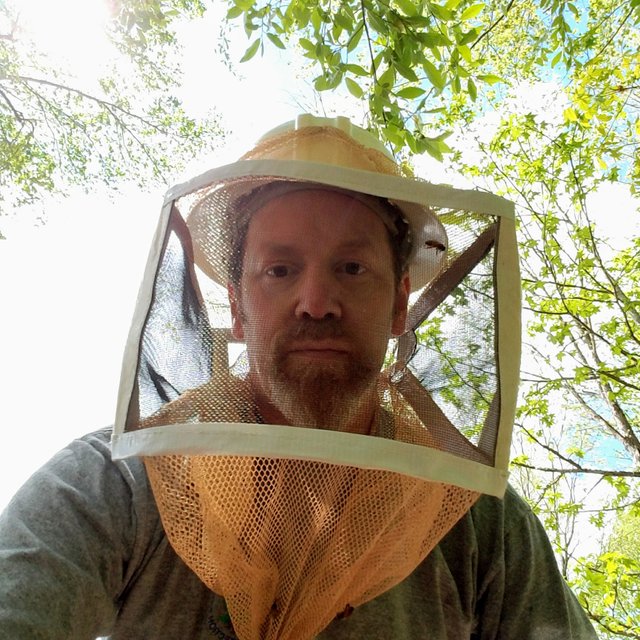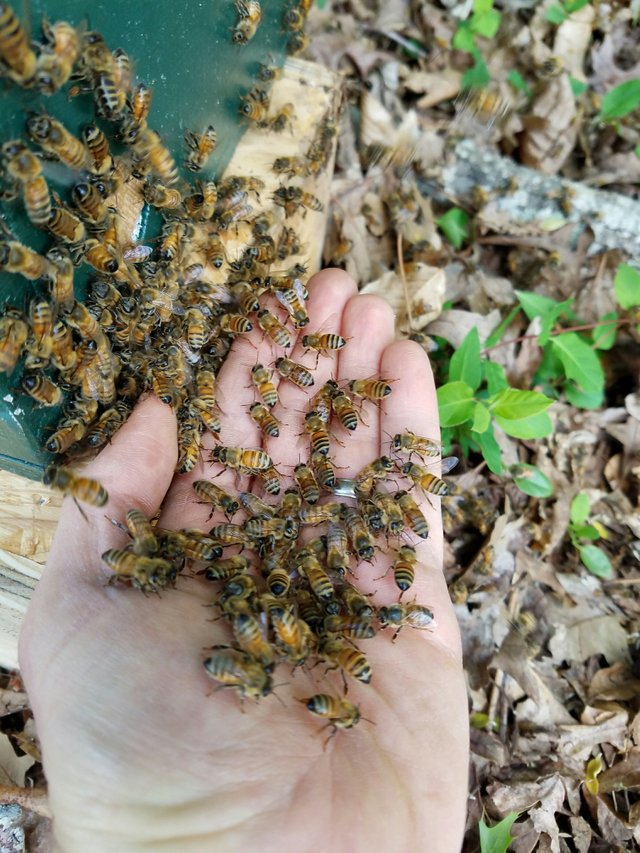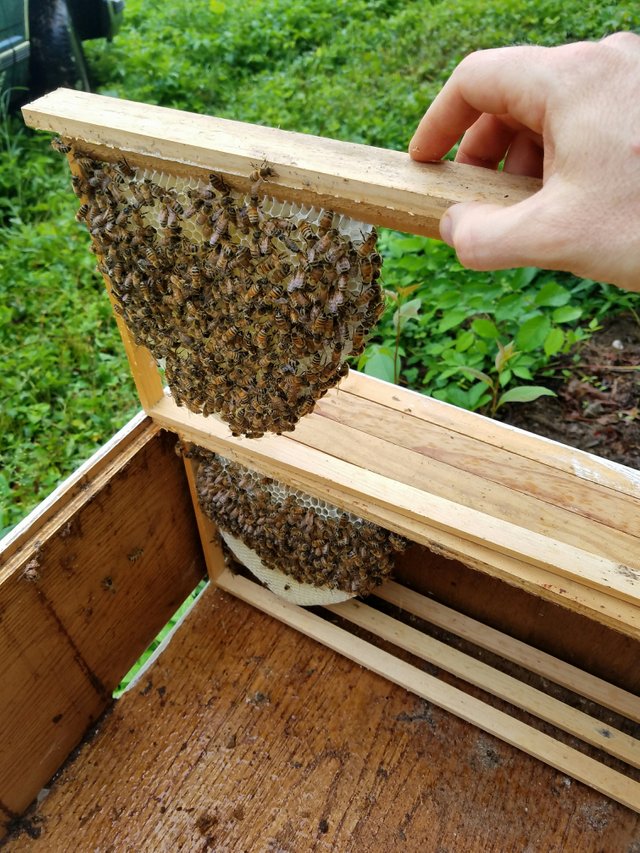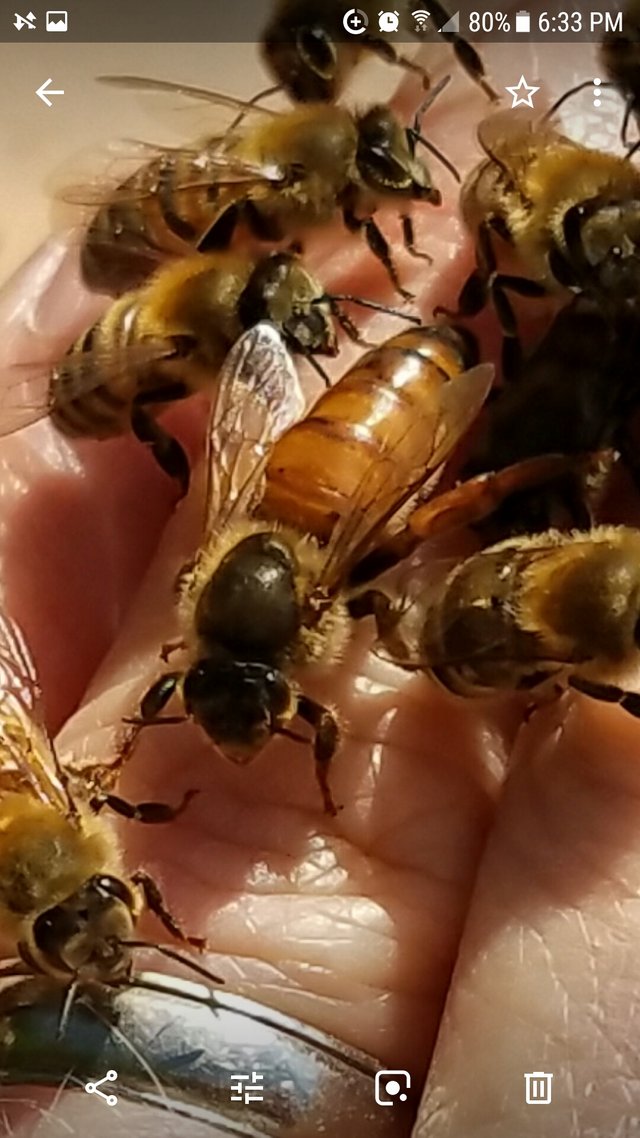HSCO Featured Vendor | Meet "Bees by Prof. Bromide"!

Hello it's me again... @SenorCoconut,
This week, we're going to ask a few questions to reflect the ethics and ideologies of one vendor at HSCO: Bees by Prof. Bromide. (@professorbromide on steemit)!
Building a community is about clear communication and the willingness to support one another. As Homesteaders Co-op (HSCO) grows, we must keep in mind that the complexity and diversity of its moving parts may also expand, so here we are helping this free market stay running smooth together.
We found it essential for the good of everyone to highlight the vendors of the HSCO market place. Wouldn't be nice to know the individuals and families offering their goods and services a little more?
Every week vendors are featured on the web site. As a community, we thought that every week, we should feature these vendors here on the Steem blockchain (@HomesteadersCoop) to give everyone that much more exposure.
It takes a village to raise a child, because when people help eachother life is easier for everyone involved.
Without further ado, here are a few question I've conjured up... let's see who is behind Bees by Prof. Bromide:
SenorCoconut: Beekeeping has always been a bit of something mystical to me… I never understood how some people have no fear when it comes to approaching a hive, they seem so powerful as a swarm. Could you please tell us about the journey that brought you to apiculture?
Prof. Bromide: I wanted to try beekeeping when I was a kid back in the 1980’s – we always had a copy of the Sears catalog in my parent’s house and I thought the beekeeping stuff was so cool. My mother encouraged me to give it a try because her uncle was a beekeeper and she thought it was so fascinating, but I never got around to it. My younger brother and sister both beat me to it; they studied horticulture and agronomy in college and could take beekeeping classes in school. I went to school for chemistry and physics and then spent 5 years in graduate school to get my PhD, so it took until 2006 before I had a chance to try beekeeping.

My first colony of bees came from a local beekeeper, which is the very best way to get started. It helps a lot to have someone who raises bees in your area to help you figure out the timing of the seasons and the local weather patterns. The man who provided my first colony is also a very interesting person to talk to. He joined the army at 18 right at the end of WWII and was sent to Europe because he learned German from his grandparents. They gave him the keys to a big touring car and he drove VIPs all over Europe to survey the rebuilding efforts after the war. It is hard to imagine the culture shock of a kid from rural Virginia in the 1940s rubbing elbows with generals and movie stars. He still keeps bees and I see him at the local bee club occasionally.
One of my neighbors found out that I was keeping bees and told me about a spot on his family farm where feral bees had been living in a hollow tree since the 1970s when his grandfather kept bees. We went over there and found the bee tree humming with activity. I put out a swarm trap nearby and caught a swarm the next spring. That feral colony has produced at least one or two swarms for me ever since.

SenorCoconut: I was looking at your shop on the Homesteaders Co-op, and reading through your honey making process. I personally know nothing about honey, except for the fact that it is delicious! You mention that "most frames contain a mixture of honey and freshly gathered pollen", does this make the honey taste more floral and do you know if the higher pollen count matters in its natural medicinal value?
Prof. Bromide: The pollen has its own, distinct flavor that it imparts to the honey. Most of the floral character comes from the nectar, though. The bees mix the pollen with enzymes from their salivary glands and a little bit of honey then they pack it into the honey comb where it ferments into bee bread. I don’t really know what plain pollen tastes like, but bee bread is tangy and rich tasting. Many of my customers like to save some local honey with pollen in it over the winter and take a little bit every day leading up to the spring pollen season. They tell me that it makes their allergy symptoms much milder than they would be otherwise.

SenorCoconut: With "climate change" every year seemingly more real, I am curious to hear from you. Have you noticed a decline in the amount of bees in your region?
Prof. Bromide: I have lived in Virginia for 18 years and I don’t know if that is long enough to notice any change in the climate. The feral bee population is definitely changing, though. The varroa mite spread through North America in the 1990s and spread some viruses that killed off a lot of bees including most of the feral colonies. There are some chemical treatments that beekeepers used to try to control the varroa mite, but the mites just developed a genetic resistance to each new poison and after a few years they stopped working. Meanwhile, the drugs were accumulating in the hives and causing breeding problems with the queens – who knows what they do to people who are exposed. The tide seems to be turning on the varroa problem now, there seem to be enough feral swarms that have natural varroa resistance that they are repopulating the bee trees and the feral populations are coming back. I do my part by catching feral swarms and giving them a good place to live, free of chemicals and anti-mite drugs. The only thing I give my bees is plain white sugar if they run out of honey at the end of the winter. Bees keep themselves warm by eating honey or sugar and shivering to generate heat. If they run out of food they will freeze to death.

SenorCoconut: While we are on the subject of climate, whether the change is man-made or not, could you please tell us what your thoughts are (without getting political) on carbon footprint?
Prof. Bromide: All of my thoughts on climate change and carbon footprints come from Radical Simplicity by Jim Merkel. He gives some detailed ways to calculate your carbon footprint, but you can get a very good approximation by looking at the number of kids you have and your household consumption in dollars per year. He explains why in the book, but the bottom line is that he limited himself to one child and limited his consumption to about $6000 per person per year, which is very close to the Federal Poverty line for a small family. There are some other factors to consider, like how much air travel you do and how you heat your house, but just looking at total household consumption is a pretty good proxy for carbon footprint.
My wife and I only have one child and are naturally very frugal people, but we don’t come anywhere near Merkel’s goal. We consume about three times what Merkel recommends. Making a significant change to reduce our consumption would probably mean selling our house and moving, which is something we will probably consider doing after my daughter graduates from school.
SenorCoconut: Let's talk beer or other thirst quenchers… As a materials and surface chemist, an inventor and a brewer, what are some of the craziest concoctions you have brought into this world?
Prof. Bromide: I’ve made some unusual mead with my honey. I don’t know of anyone else who has made sumac mead, but it is very good. Sumac berries are very tart and astringent, which is a good compliment for honey. You just need to break off the sumac bobs when they turn dark red and swish them around in some warm water to dissolve the acid and tannin. If you strain the liquid and add a little honey it is similar to lemonade, but sumac has its own unique flavor that isn’t like any other fruit that I know off. To make mead you just add about 3 ½ pounds of honey per gallon of sumac tea and a packet of wine yeast. Mead ferments very slowly, so it might take a couple months even if you keep it warm. When it quits fermenting you siphon it into another container and let the yeast settle for another month, then siphon it again. It should be ready to bottle in about 6 months.
I kind of went on a hunch, asking you about making tasty beverages and I'm glad I did!!! What an awesome mead that sounds to be... and telling us how to make it like you did, that is one of the reasons I love this Homesteaders Community on the blockchain!
I am glad to hear that feral swarms with a natural varroa resistance are repopulating. You sure have a passion for what you do and that's really inspiring.
Thank you very much @professorbromide for letting us have a peak into the life of a beekeeper, I'm happy to have learned something about these awesome little creatures today!
For those of you who would like to look into this shop at HSCO here's a quick link: Bees by Prof. Bromide!
Thank you so much for reading and stay tuned for next week's featured vendor... Same time, same place!
PS: Special thanks to @Riverflows for the graphics on that first image at the top of the post 💚 and of course @Homesteaderscoop for being an awesome community!
A Free Marketplace for Steem
We provide a FREE marketplace for you to transact in STEEM, SBD and USD. Our co-op vendors are committed to sustainability, ethics and quality in their lives and work.
Unlike other marketplaces our vendors are not charged listing fees, subscription fees or transaction fees. This service is 100% free to them.
Support our alternative economy:
- Join the conversation in our Discord Group
- Purchase handmade products with STEEM, SBD or USD at https://homesteaderscoop.com
- Spread the word that sustainable vendors are accepting STEEM, SBD and USD
- Up-vote our posts at @homesteaderscoop
- Follow our Curation Trail on SteemAuto to automatically upvote our contributors and vendors
- Delegate SP to @homesteaderscoop
- Donate to our ongoing Fundition project
Why Delegate to Homesteaders Co-op?
Your delegations will help us grow our community and reward our members for their ethical choices and actions.
In our modern world it is not always easy to choose to live sustainably. To do so often means forgoing income potential and the status quo. Our SteemPower is used to up-vote Homesteader Co-op contributors and vendors in order to reward and support their hard work. Some extra STEEM may one day go a long way for some individuals of our community.
10 SP | 25 SP | 50 SP | 75 SP | 100 SP | 200 SP | 500 SP | 750 SP | 1000 SP
Who is Homesteaders Co-op?
Get to know our mission in our introduction postWant to sell sustainable, handmade products for STEEM, SBD and USD?
Learn more and apply here

Great interview. We just started keeping bees. We're very excited, I brew beer and can't wait to try my hand at mead. Great idea to add something like sumac.
I love the idea of adding sumac too... I made the mistake to cut down a few small staghorn sumacs on my property the let the wild berries prosper!!! There's a small sumac forest growing in place of it now.
Good luck with your bees. Let us know how your season progresses.
Posted using Partiko Android
while we're on the subject of sumac... Professor, you said to make the tea we need warm water because it'll dissolve the tanin. Thank you for that... is that all it takes? I had been making tea by letting the flowers seep over night in room temperature water.
A longer soak at a lower temperature might be better. I don't know. It is worth doing an experiment.
Posted using Partiko Android
Oh I never thought about doing such an experiment... I'm sure I could figure out somehow how to test it.
Great interview! You asked a lot of great questions , @senorcoconut!
@professorbromide, you are living part of my dream! So amazing to see these beautiful images and learn from a studied apiarist ! I had no idea that there had been a genetic adaptation for the varroa mite! That is truly incredible to hear.
With this adaptation, has there been a decrease in the instances of colony collapse disorder?
There are three behavioral adaptations that help to control the varroa mites. Some bees can smell the breeding mites on brood and will drag the infested brood out to dispose of them. It sounds brutal, but it is very effective. Other bees are very aggressive about cleaning mites off of each other. I've seen this behavior in my bees and it is fun to watch. The last adaptation is just making a pause in brood rearing during midsummer droughts. The mites can't breed if there is no bee brood to host them.
That last adaptation has been bred out of all of the bees that are used in commercial apiaries. Commercial beekeepers always want maximum productivity. That is why I like to use the feral bees, they are not as productive but they are tough.
There are probably some other genetic variations that help the bees deal with the viruses spread by the mites. You can't directly observe those adaptations but they are certainly valuable.
I don't know if we ever got a full explanation of what caused colony collapse disorder. The strongest hypothesis blames tiny doses of neonicanoid pesticides that don't kill the bees, but ruin their nervous system. We don't have a lot of intensive agriculture here in central VA, so neonics are not a problem.
Posted using Partiko Android
Oh wow, they're just amazing... It seems everything in our ecosystem is so much stronger than any domesticated version.
Of course feral bees are more resiliant!!! It makes so much sense.
Thanks again for another lesson
Thank you very much @Alchemage! I learn quite a lot through these interviews.
Thanks for putting up this post, @senorcoconut! The jars just arrived, so I will start bottling my honey harvest this weekend. It should be up for sale soon.
Posted using Partiko Android
You're welcome and again, thank you so much for taking that time to answer. 😁
GREAT interview @senorcoconut and a timely one for me: have not encountered @professorbromide before now and am happy to make his acquaintance indirectly - am just starting a bee project-journey here in Northern Thailand and he is DEFINITELY someone to be following and learning from. Much gratitude.
Leading the curation trail for both @ecotrain & @eco-alex.
Together We’re Making This World A Better Place.
Click Here To Join the manually curated trail "@artemislives" to support quality eco-green content.
@ecoTrain
Congratulations @homesteaderscoop! You have completed the following achievement on the Steem blockchain and have been rewarded with new badge(s) :
You can view your badges on your Steem Board and compare to others on the Steem Ranking
If you no longer want to receive notifications, reply to this comment with the word
STOPI'm looking forward to hearing about beekeeping in South Asia. As the ancestral home of honeybees, I expect there are more varieties of bees available.
Posted using Partiko Android